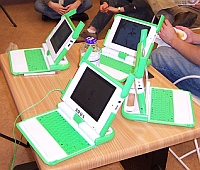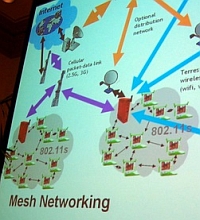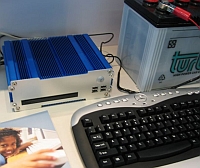Browsing through the archives here at OLPC News and over on the official "Community-news" mailing-list I noticed that there's one topic that hasn't really been discussed all that much: the OLPC school servers.
Reading through Walter Bender's weekly updates to the mailing list there are only few recent mentions of the school server. In early March he wrote that "software architecture of the school servers is starting to come together". Then 4 weeks later he mentions that "the school server development continues" and "applications and content for the Library are starting to be installed". Development went on throughout April and apparently there's one trial setup being used at the OLPC offices in Cambridge but as of May 5 "work on the School Server hardware design continued".
With regards to the OLPC Wiki there are several entries dealing with school servers but there's relatively little in terms of (f)actual information. I assume this is also the reason why Walter Bender called the Wiki entries "really more of an introduction".
Now, why would I go on to talk about the school servers, wasn't mesh-networking implemented in order to get rid of a centralized network infrastructure that required servers and routers? Well, unfortunately things aren't that easy.
While the mesh-networking in the X0s does an outstanding job of connecting different machines to each other, streaming audio between system A and system C by using system B as a proxy (see "4. FISL8.0" in this mailing list update) and a million other things the whole OLPC technical infrastructure still heavily relies on (school) servers.
The OLPC Wiki puts it this way:While the laptop is rightfully at the center of OLPC, a valuable peripheral is the school server. OLPC will be building and distributing school servers along with the laptops, to extend the storage and computation provided by each laptop, as well as providing a local library and a mesh portal to the Internet.
In recent weeks I have realized that the school servers are probably much more important than I had previously thought. It's not only about providing internet access to the mesh-network like I had always assumed. The OLPC Journal will heavily rely on the school servers for backups and for extending the limited flash-storage on the X0s. Moodle, an offline Wikipedia and similar solutions will probably also need to use school servers. They could expand on thier distributed storage system, content in tiers, where each X0 machine provides a small selection of Wikipedia articles inside the mesh-network. However, even that would need a central repository to coordinate with.
The best idea of what the final school servers could be like is to look at the entry of the XSX prototype school server and the Trial 1 server software. In terms of the hardware the current prototypes use off-the-shelf components. At the heart of the XSX setups are fanless Mini-ITX motherboards by VIA Technologies, more specifically the EPIA CN10000E and EPIA EN12000E which are both built around the VIA C7 CPU and VIA CN700 chipset. These setups come with 1GB of DDR2 memory and apparently 300GB+ 3.5" S-ATA hard-drives are recommended to be used. Access to the internet will be provided via a 10/100MBit NIC while 3 Marvell USB Wifi nodes will connect the school server to the mesh-network.
Looking through that information I was a bit surprised that OLPC is apparently working on a custom solution with its own "industrial and mechanical design". Especially since VIA Technologies already offers a hardware platform that seems to perfectly fit OLPC's requirements.
The so-called VIA PHD (Power, Heat, Dust) systems are part of VIA's PC-1 initiative. Fortunately the OLPC Wiki states that "Individual countries will be free (even encouraged) to design and manufacture their own school servers running derivatives of the OLPC school server software."
So instead of spending precious time and resources on a completely new hardware solution I'm thinking that going with an existing setup would probably be the better (and potentially even cheaper) option for countries committed to the OLPC program. When it comes to the software side of things the information available at the moment is still somewhat blurry and fuzzy.
While there's some talk about the capabilities the school servers should have it's still not quite clear what software exactly they'll be running on. (Windows Server 2003 anyone?) One very interesting and important question that's closely tied to the software is who will be managing be school servers. As the OLPC Wiki puts it: "How are services on the School server installed, configured, managed, and updated ?"
In the end I have to say that I'm a bit surprised that the school servers have received so little attention up to now. Somehow the topic never seems to have appeared on anyone's radar - and that of course includes myself. After digging into this issue over the past few days I noticed that I started out with only a few questions, found some answers but a large number of new question-marks have started popping up all over the place.





I think it was menshionned that the server could cost 200$, come with 200GB, and one of the uses of the server is to download from a download-only cheap satellite linkup during 24-hour broadcasts of gygabytes of daily content, which the children can then come and watch, browse through or use on their laptops.
In terms of text, 200GB is enough for like one or two libraries of alexandria, or maybe not that much, but at least 200GB for text is huge. And for well compressed videos, games, music, movies, there would be a system that makes sure to keep the hard disc full of content that are calculated to be usefull during the classes, and somehow the users usage of the system can then adapt for which content to update..
As far as I have heard, the Mesh provides an amazing sharing of memory, so if you have 100 XO-1s in a mesh, they are actually able to share up to 10s of GB of data, since certain books, parts of the offline wikipedia, parts of videos and other such multimedia files can stay hosted on certain power nodes on the mesh, and maybe also power usage statistics can predict which node is less likely to stay running so certain more popular content might move from one laptop to the other to prevent that content from going offline, maybe even that when the kid wants to put the laptop to sleep, it might quickly try and copy out the certain files to surrounding laptops before actually really going to sleep.
I also think that Google has a lot of functionnality inside of the School Server. It's quite huge to integrate Gmail, Google Video, Google Docs maybe even Google Search where the School Server might be hosting an index of the most used Google Search results so that when there is no available upload and only a satellite one-way downlink, that the students still can access somekinds of content searches.
Of course the goal is to connect every school to the Internet, but if the Internet connection is not yet available, the the school server together with a 100$ Satellite dish could still provide lots of up to date content.
Christoph,
**********
from the strategic point of view of OLPC I could imagine two reasons for putting together their own hardware instead of using the VIA PHD. The begin with the VIA PHD is a for-profit product whereas OLPC's strategy is to deliver hardware without allowances for marketing and profit. The second is flexibility and openness. E.g. a specialized openBIOS might be adapted to special needs like extra functions for power management like wake up functions and the like.
Charbax,
********
"It's quite huge to integrate Gmail, Google Video, Google Docs maybe even Google Search where the School Server might be hosting an index of the most used Google Search results so that when there is no available upload and only a satellite one-way downlink, that the students still can access somekinds of content searches."
you mentioned different possibilities of OLPC's integration with Google services. I was only aware of Gmail and storage services. How much of these other possibilities are really planned? Do you have any facts or testimonies on that?
Do you see any issues concerning dependency, privacy, conflict with commercial interests if the integration becomes so intimate? Will the kids be protected from tons of ads and commercials? Will their search behavior also be used to create psychological profiles about them like on us? At least we have a choice not to use Google. Will the kids also have such a choice?
The school server provides infrastructure for the community based activities that are so much a part of the OLPC system.
The Sugar developers (according to the mailing list) are putting a lot of time into deciding how Sugar allows users to share activities between friends. So far the school server is an integral part of the network and in many respects it would be hard to imagine using XO laptops without a server and the all important wireless access points.
The school server also provides space for the laptops to store excess information that might overflow from the journal as well as providing network and internet access.
The question is -: will XO users have activity sharing without a school server present?
Good for School ^__^
Roland,
You say "VIA PHD is a for-profit product" as if OLPC isn't using product from for-profit companies. Every single component and even the assembly of OLPC's is from for-profit companies that stand to make millions from the laptop's production. http://www.olpcnews.com/hardware/production/olpc_taiwan_computer_production.html
In addition, the last time I checked, OLPC was going to use off-the-shelf computers for servers in the near term. Those servers would be for-profit product also.
At least the PHD would be energy efficient, a tenant of OLPC thought.
Wayan,
strictly thought you are right. However, there is an important distinction. The profit made with XO's parts and its assembly is reduced to much much lower levels than usual with standard off-the-shelf products. This is because of the large scale production. If those companies still make millions it is only due to the high multiplication factor. Their profit as a percentage of the final product cost is probably very low compared to normal products. That's Negroponte's whole idea of only selling XOs in junks of first 1 million and now a quarter of a million in order to benefit from the scale effect from the beginning.
So I guess OLPC also wants to benefit from this scale effect with the servers of which still about 5 thousand per million XO's are going to be needed. I guess that also the maintenance during their service will be easier if they have all the same hardware.
Wayan,
Might not the mesh networking be one of the problems with commercial servers?
The mesh of the school server must be always on, on low power. There might be BIOS adaptations.
Furthermore, teh school server is used for the cryptographic authetication of children's laptops, the ID information, and the software upgrades. It also contains the personal keys of the children. If someone hacks a school server, s/he might do aweful things to the project and the children.
For cryptographic security, the OLPC project might want to have a say in the Bios, HW, and Firmware of the server.
Winter
Roland & Winter,
My only point was to illustrate to Roland that OLPC is using commercial products already and the volume pricing benefits would work for any product. OLPC is already using the PHD chipset in their initial School Server Version 1 design: "XSX setups are fanless Mini-ITX motherboards by VIA Technologies."
I agree with Christoph that starting with that setup and expanding on it using the PHD reference design as a start could be quicker. BIOS, mesh, etc are already added in. Of course if the AMD chipset can handle server loads with OLPC's power management, that would be the easiest from a maintenance perspective.
What I don't (and nor would you) want to see is standard commercial servers with all their attendant electricity use and delicate environmental requirements sucking up resources in rural schools because OLPC couldn't get their own specially designed School Server Version 2.0 out in time.
Charbax,
what information do you base your comments on? I did quite a bit of research about the school-servers last week when writing this post but most of what you're saying is still new to me... Especially all that (frightening I dare say) Google integration! I also know that some people outside of the OLPC core team have thought about distributed data-storage built around the Mesh network. However at the moment I'm not aware of an actual implementation that does that.
Roland, Winter,
as Wayan already pointed out every entity involved in the X0 production is a for-profit company. The margins are certainly razor thin but everyone still makes money, especially when millions of X0s are being produced. So there's no reason to believe that VIA (or any other company) wouldn't be willing to agree to the same deal.
With regards to the hardware the EPIA motherboards (which are nearly identical to the PHD setups) are obviously adequate for the pre-production tests that are taking place right now. In terms of the Mesh network the school servers are going to be connected to it via Marvell's USB dongles if I'm not mistaken. As far as the BIOS goes I know that some guys managed to run LinuxBIOS on some EPIA motherboards. Speaking of cryptographic security the VIA CPUs all come with the PadLock encryption features which is one of the most efficient implementations of high-speed data encryption in low-power processors that I'm aware of. So I can think of no technical reason why the PHD setups wouldn't work! Especially since the AMD Geode LX platform certainly isn't powerful enough to be used in the school servers so OLPC will have to go with a different technology anyway.
In the end I think that the resources, time and brain-power spent on coming up with a custom school server solution would be better spent elsewhere.
I recall reading somewhere that one problem they were struggling with for the server is the danger of theft. The problem stated was that hard drives are easy to sell, which would make the servers tempting targets.
Greetings from the heart of Bavaria, Germany. We are a small software company, with many years experience in WiFi access control i.e. controlling who gets ono the network and how much data they can up and download (quota). I am trying to find out, if our software would be useful for the School Server. Can you point me towards the folks responsible for the School Server ?
Best regards
Paul Cullen
P.S., here is a link to an article about what we do:
http://www.garderos.com/publications/WiFi_Connection_Sharing.pdf
OLPC is making school server progress. From the community news:
John Watlington announced a build (125) for testing. It is missing a number of crucial services, but verifies the build and installation process and supports laptops on the mesh. [School servers] should install on most x86 platforms, requiring only an Active Antenna to provide the mesh interface. More information is available from the wiki (See XS_Server_Software).
You can also obtain the Live CD image (from http://xs-dev.laptop.org/xs/OLPC_XS_LATEST.iso). Release notes and installation instructions are also in the wiki (See http://wiki.laptop.org/go/XS_Server_Software ). Over the next week, we hope to include all required services in this build. Thanks go to Holger Levsen, Dan Margo, Scott Ananian, and RedHat team.